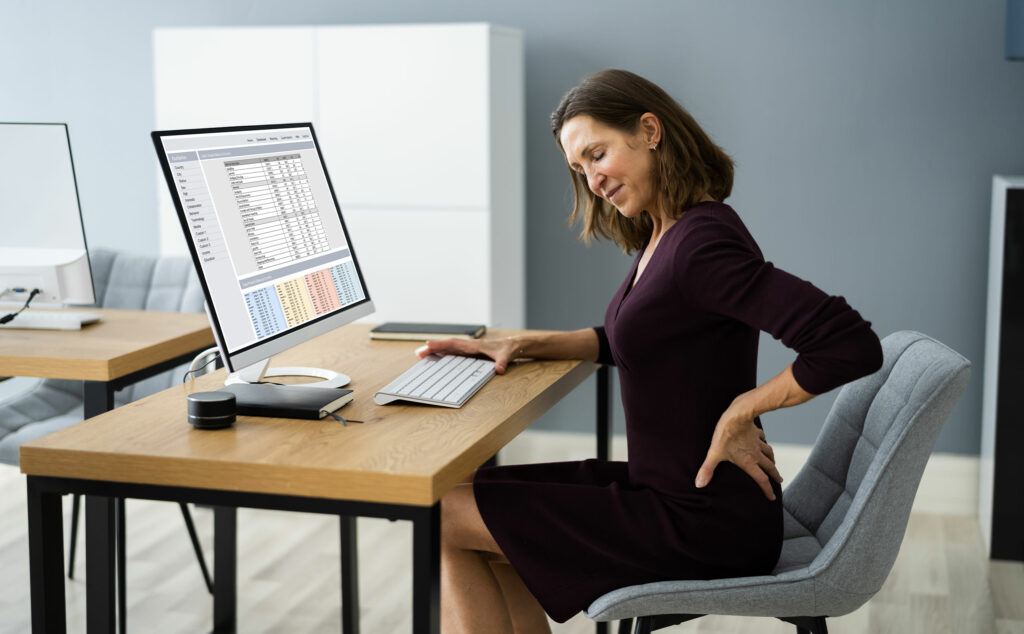Key points:
- Poor sitting postures and habits can trigger back and neck pain and injuries.
- The workplace is one of the main places where back pain can be triggered.
- Hunching over, overstretching the back, and having a severely bent neck all contribute to back pain.
On average, more than a third of the day happens at work, which means that this place is one of the main ones that could cause an injury to the cervical or lumbar spine, says Dr. Ulises García González, neurosurgeon at ABC Medical Center.
The specialist says that it is normal for patients to come to see him because they have neck or lower back pain, and when questioned, many times, the origin of the pain is due to bad posture, bad habits, and, in short, poor spinal hygiene.
Although many positions at work can trigger some pain or discomfort, some are the most recurring and that it would be best to avoid.
“Bad postures range from the way you sit in front of the computer, the bad position of the neck and head, as well as how we position our arms and wrists while typing on the computer. A sedentary lifestyle is a factor for non-communicable chronic diseases, but it is also a problem for our backs.”1
Hunchback pose
Due to fatigue, the abdominal muscles become flaccid and force the person to adopt a slouchy and inappropriate posture. This posture results in pain in the lower, middle, and cervical spine.
The correct thing would be for the person to get their chair close enough to the work area (desk or table), they should also ensure that the lower back is in contact with the back of the chair. Also opening the legs in a compass of between 30° and 40° will automatically maintain an upright posture, while the muscles of the abdomen and back relax, resulting in an ergonomic position, says Dr. Garcia.
Beach pose
Leaning back in a chair, although it initially seems like a comfortable thing to do, results in a very damaging action for your lumbar and cervical spine.
Due to the position you take, you will end up without exerting support on your lower back and you will put the weight of your head and neck on the back of the chair, causing inadequate pressure on this area of the body.
In addition to this, the posture is bad because it forces the curvature of the lumbar spine to be reversed, all of this, not being an anatomically correct position, will cause pain and discomfort in the back.
Executive sitting
Many times, during work and meetings, we want to appear very comfortable and confident while taking a seat. In this position, one leg is crossed over the other, resulting in the weight of the trunk falling only on one side of the lumbar spine, causing inflammation of the ligaments of the back and, consequently, pain.
Dr. Garcia says that something to keep in mind is that crossing one leg isn’t necessarily a bad thing, it just needs to be done with proper technique, which can promote good circulation and stretch the hip ligaments and muscles. This will help keep you from getting fatigued while sitting.
Sitting in front of the computer
During working hours it is very common to spend a lot of time sitting in front of the computer, which can result in positions that are harmful to the body if they are not applied correctly.
Having the computer screen below eye level causes you to work with your neck bent, resulting in stress and pain in the cervical region, mainly. On the other hand, if the monitor is above eye level, tension will be conditioned on the posterior muscles of the neck, which will also cause pain.
The correct posture when working in front of a computer is to look for a 90° angle between the chin and the torso, by using this posture you will realize that you do not have tension on the neck muscles.
Regarding the body, you must make sure that when you sit you can place the soles of your feet completely on the floor, this will help you rest the knee and hip joints, favoring the harmony of your position and your back posture.
Text neck syndrome
This disease is new and has developed due to the inappropriate use of technology. It is very normal for people to grab the cell phone and hold it at chest level while using it, this causes us to bend our neck down a lot, which leads to inadequate tension and excessive stretching of the ligaments and muscles of the posterior region in the cervical spine. Maintaining this position for a long time will often trigger chronic pain.
If you begin to perceive stinging, burning, or pain in the posterior region of the neck, mainly in the area that joins the dorsal and cervical spine, it may be an indication that you are having Texter syndrome, says Dr. Garcia.
Your spine is important, therefore, it is necessary to consider all the recommendations to achieve correct spinal hygiene and thus avoid unnecessary pain or damage that, above all, is preventable.
At ABC Medical Center’s Neurology Center, we can provide you with specialized care. Contact us!
Fuente:
Dr. Ulises García González – neurosurgeon at ABC Medical Center
https://youtu.be/KZ3zxywyW1k
1https://www.gob.mx/salud/articulos/si-puedes-cuidar-tu-espalda-mientras-trabajas

